| SILKYPIX® Developer Studio 3.0 | SOFTWARE MANUAL |
| 9. Setting | ||||||||
9.1 Setting for Developed Image
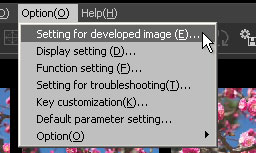 The menu command [Option(O)]-[Setting for developed image(E)] displays the "Setting for developed image" dialog, in which you can specify the type of the image file developed by SILKYPIX.
The menu command [Option(O)]-[Setting for developed image(E)] displays the "Setting for developed image" dialog, in which you can specify the type of the image file developed by SILKYPIX.9.1.1 Setting of File Type
In this software, you can save a TIFF file as non-compressed format and a JPEG file as compressed format.
We recommend you to use TIFF when you do not want to deteriorate a developed result in this software or when you process a file with photo retouching software.
When you process a developed image file with photo retouching software, it is advantageous to save it as the 16-bit data that are useful for high gradation.
When you want to reduce a saved file size, JPEG is suitable for saving. However, since a picture will deteriorate, you should set an optimal compression ratio as usage.
In addition, you can record Exif information into an output file. Refer to '10.4.2 Exif Information' for more details.
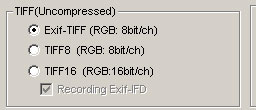 (1) Non Compressed Format
(1) Non Compressed Format
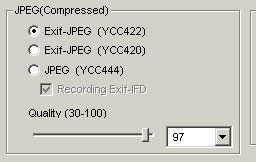 (2) Compressed Format
(2) Compressed Format
9.1.2 Option for JPEG/TIFFWe recommend you to use TIFF when you do not want to deteriorate a developed result in this software or when you process a file with photo retouching software.
When you process a developed image file with photo retouching software, it is advantageous to save it as the 16-bit data that are useful for high gradation.
When you want to reduce a saved file size, JPEG is suitable for saving. However, since a picture will deteriorate, you should set an optimal compression ratio as usage.
In addition, you can record Exif information into an output file. Refer to '10.4.2 Exif Information' for more details.
 (1) Non Compressed Format
(1) Non Compressed FormatYou can select a TIFF file type from following three types.
RGB Exif-TIFF (8-bit)
RGB Exif-TIFF (8-bit)
This is non-compressed format TIFF in conformity with EXIF standards, 1 channel is 8-bit and has R,G,B 3 channels including EXIF information.
RGB TIFF 8-bitThis is non-compressed format TIFF, 1 channel is 8-bit and has R,G,B 3 channels without EXIF information.
RGB TIFF 16-bitThis is non-compressed format TIFF, 1 channel is 16-bit and has R,G,B 3 channels.
You can attach the EXIF information into this TIFF file if you check the "Recording Exif-IFD" checkbox.
* "16-bit TIFF" is not prescribed in the Exif Standards.
You can attach the EXIF information into this TIFF file if you check the "Recording Exif-IFD" checkbox.
* "16-bit TIFF" is not prescribed in the Exif Standards.
 (2) Compressed Format
(2) Compressed FormatYou can select a JPEG file type from the following three types and specify the quality coefficient.
Regarding the quality coefficient, a smaller value makes the smaller file that records lower quality image, and a larger value makes the larger file that records higher quality image.
Exif-JPEG (YCC422)
Regarding the quality coefficient, a smaller value makes the smaller file that records lower quality image, and a larger value makes the larger file that records higher quality image.
Exif-JPEG (YCC422)
This is a JPEG file including the EXIF information which has 2 pixels of color information per 4 pixels of lightness information.
This is the most popular format. Because only a half of the chroma information is recorded, the compression ratio becomes higher, however, color separation degrades at a fine area.
Exif-JPEG (YCC420)This is the most popular format. Because only a half of the chroma information is recorded, the compression ratio becomes higher, however, color separation degrades at a fine area.
This is a JPEG file including the EXIF information which has 1 pixel of color information per 4 pixels of lightness information.
The chroma information is recorded less than YCC422 described above. Therefore the size of the file becomes smaller but the image quality degrades more.
JPEG (YCC444)The chroma information is recorded less than YCC422 described above. Therefore the size of the file becomes smaller but the image quality degrades more.
Because all chroma information is recorded, the size of the file becomes larger and the degradation of the image quality is less.
You can attach the EXIF information into this JPEG file if you check the "Recording Exif-IFD" checkbox.
* JPEG YCC444 format is not prescribed in the Exif Standards.
You can attach the EXIF information into this JPEG file if you check the "Recording Exif-IFD" checkbox.
* JPEG YCC444 format is not prescribed in the Exif Standards.
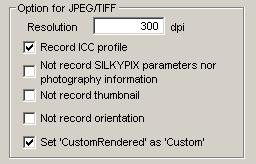 When the development result is saved in the JPEG/TIFF file, incident information is saved together, for which option is set on the Option for JPEG/TIFF.
When the development result is saved in the JPEG/TIFF file, incident information is saved together, for which option is set on the Option for JPEG/TIFF.This setting does not have any influences on the results of the picture. Only the incidental information recorded in the image is influenced.
[Resolution]
The recorded "resolution" in JPEG and TIFF is defined here. The default setting is 300dpi. Even if you increase the dpi setting, the resolution of an outputted picture does not change at all. The value set here is recorded in EXIF information, and used as a standard to convert it into an actual size when the image is displayed or is printed.
If a software is not compatible with the dpi information, this setting does not have any meaning. If you do not understand this setting well, please use the default setting.
[Record ICC Profile] If a software is not compatible with the dpi information, this setting does not have any meaning. If you do not understand this setting well, please use the default setting.
 You can specify whether to record the ICC profile which indicates colorspace into an output JPEG/TIFF file. It is checked in the default.
You can specify whether to record the ICC profile which indicates colorspace into an output JPEG/TIFF file. It is checked in the default.If you are using the photo retouching software which is compatible with color management, namely, a recorded profile, it can transfer the colorspace information correctly.
This setting allows you not to record the information into a JPEG/TIFF file, which is the information about taking a photograph and the development parameter of SILKYPIX®.
This setting is not checked in the default.
The photography information is recorded in the information tag of EXIF, which includes all data of the photography and the time and date. The development parameter of SILKYPIX® is stored in "Makernote" tag of the EXIF information.
Please use this setting if you do not want to disclose the information about taking the photograph and developing with SILKYPIX®.
[Not record thumbnail]This setting is not checked in the default.
The photography information is recorded in the information tag of EXIF, which includes all data of the photography and the time and date. The development parameter of SILKYPIX® is stored in "Makernote" tag of the EXIF information.
Please use this setting if you do not want to disclose the information about taking the photograph and developing with SILKYPIX®.
This setting allows you not to record the thumbnail into a JPEG/TIFF file, This setting is not checked in the default.
[Not record orientation]This setting allows you not to record the orientation information to the "Orientation" tag of EXIF. This setting is not checked in the default.
[Set 'CustomRendered' as 'Custom']This setting is specified to record "CustomRendered" tag of EXIF as "Custom" or "Normal". This setting is checked in the default.
When this setting is checked, it is recorded as 'Custom process' to the 'CustomRendered' tag. It indicates the special processing was performed, and a next process is expected to disable or minimize any further processing.
When this setting is not checked, it is recorded as 'Normal process' to the 'CustomRendered' tag. It doesn't expect like the above to a next process.
If this setting is checked, for example, the image processings such as the automatic correction will not be performed when requesting the print of the photograph by the DPE service.
If you expect some image processing to a next process, please remove the check of this setting.
Since SILKYPIX® presupposes the output of the complete image which incorporated the intention of the user, it expects a next process to disable or minimize any further processing in the default setting.
When this setting is checked, it is recorded as 'Custom process' to the 'CustomRendered' tag. It indicates the special processing was performed, and a next process is expected to disable or minimize any further processing.
When this setting is not checked, it is recorded as 'Normal process' to the 'CustomRendered' tag. It doesn't expect like the above to a next process.
If this setting is checked, for example, the image processings such as the automatic correction will not be performed when requesting the print of the photograph by the DPE service.
If you expect some image processing to a next process, please remove the check of this setting.
Since SILKYPIX® presupposes the output of the complete image which incorporated the intention of the user, it expects a next process to disable or minimize any further processing in the default setting.
These are the setting how to develop to a JPEG/TIFF file. These setting affect the developed image itself.
[Rotation: Rotating images to save]
 You can specify whether to record the rotated image or to record the non-rotated image.
You can specify whether to record the rotated image or to record the non-rotated image.
When this setting is checked, a developed image will be rotated as same orientation as a preview image.
When this setting is not checked, a developed image will not be rotated. In this case, the orientation information is separately recorded in the EXIF information if the "Not record orientation" described above is not checked.
When you use the software which is compatible with the orientation information (like this software), the picture will be displayed which is rotated with the orientation information. In this case, you cannot distinguish the differences whether this setting is checked or not.
If you disable this setting, all developed images will be same orientation. It is useful when you use the same action of the photo-retouching software at a later stage.
[Output colorspace]
 You can specify the working colorspace and the output colorspace. Regardless of the colorspace which has been set as a development parameter, you can execute development with the colorspace of "sRGB" or "Adobe RGB."
You can specify the working colorspace and the output colorspace. Regardless of the colorspace which has been set as a development parameter, you can execute development with the colorspace of "sRGB" or "Adobe RGB."
It is useful, for example, if you would like to print out with "Adobe RGB" colorspace and also save JPEG files for web site with "sRGB" colorspace, you need not change each development parameter.
9.1.4 Default Folder to Save[Rotation: Rotating images to save]
 You can specify whether to record the rotated image or to record the non-rotated image.
You can specify whether to record the rotated image or to record the non-rotated image.When this setting is checked, a developed image will be rotated as same orientation as a preview image.
When this setting is not checked, a developed image will not be rotated. In this case, the orientation information is separately recorded in the EXIF information if the "Not record orientation" described above is not checked.
When you use the software which is compatible with the orientation information (like this software), the picture will be displayed which is rotated with the orientation information. In this case, you cannot distinguish the differences whether this setting is checked or not.
If you disable this setting, all developed images will be same orientation. It is useful when you use the same action of the photo-retouching software at a later stage.
 You can specify the working colorspace and the output colorspace. Regardless of the colorspace which has been set as a development parameter, you can execute development with the colorspace of "sRGB" or "Adobe RGB."
You can specify the working colorspace and the output colorspace. Regardless of the colorspace which has been set as a development parameter, you can execute development with the colorspace of "sRGB" or "Adobe RGB."It is useful, for example, if you would like to print out with "Adobe RGB" colorspace and also save JPEG files for web site with "sRGB" colorspace, you need not change each development parameter.
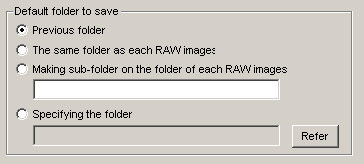
You can specify the default folder to save the developed JPEG/TIFF files. This is a default setting for the "Save as" dialog and you can modify to any folder for saving every time.
This setting does not affect for the "Batch development" function, because it has another setting for itself.

You can specify the default filename to save the developed JPEG/TIFF files. This setting is "%N" in the default, which means the same as the basename of each RAW data file.
This is a default setting for the "Save as" dialog and you can modify to any filename for saving every time.
This setting is also used for the "Batch development" function.
You can set the control character here. Click [Base], [Focal Length], [F Number], [Shutter speed], [ISO speed], [Date/Day], or [Time] button, the related control character is input automatically.
If the [Initialize] button is clicked, it will initialize to "%N". You can also use your keyboard to input any character directly.
[Control characters for specifying default filename]
| %N | ... | Basename of the RAW data file ("Basename" means a part of filename except the extension) |
| %I | ... | ISO Speed |
| %L | ... | Focal Length |
| %F | ... | F Number |
| %T | ... | Shutter Speed |
| %Y | ... | Date Time - Year (2 digit) |
| %y | ... | Date Time - Year (4 digit) |
| %M | ... | Date Time - Month |
| %D | ... | Date Time - Day |
| %h | ... | Date Time - Hour |
| %m | ... | Date Time - Minute |
| %s | ... | Date Time - Seconds |
| %% | ... | Method of describing '%' |
9.2 Display Setting
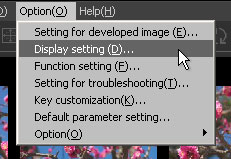
The menu command [Option(O)]-[Display setting(D)] displays the "Display setting" dialog, which you can specify about color management, control location and other display settings.
9.2.1 Color Management
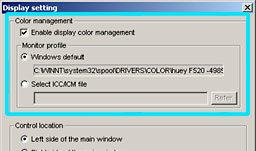
This setting specifies the color management for your display/monitor.
If you check this setting, the color management is enabled and the selected monitor profile is applied for the displayed image.
We recommend you to enable the color management and select the suitable monitor profile for your display/monitor.
The monitor profile is sometimes distributed by the manufacturer, please check the web site of the monitor manufacturer.
The best way is to select your own monitor profile for your environment created by any color matching utilities.
You can reproduce the correct color on your display/monitor with color management.
If you use "Adobe RGB" colorspace, we strongly recommend you to enable the color management.
9.2.1.1 Monitor Profile
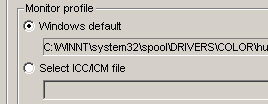 If "color management" is enabled, you can specify a monitor profile by the following two ways.
If "color management" is enabled, you can specify a monitor profile by the following two ways.(1) Use the default monitor profile set in the OS. About how to specify a monitor profile to the OS, refer to your OS manual.
(2) Select a monitor profile (ICC/ICM file) from files. You should specify a monitor profile that is defined in XYZ-RGB format.

You can specify the location of the "parameter control" that is main GUI control. You can set it left side (default) or right side in the main window, or change it to a floating windows.
 |

You can specify the number of horizontal scenes for thumbnail view, and the order of sort.
Please refer to '3.14 Sort Thumbnail' for the detail about thumbnail sorting.
 [Enable "Grid setting" dialog in grid mode]
[Enable "Grid setting" dialog in grid mode]If this setting is checked, the "Grid setting" dialog will be displayed while the grid is displayed. This setting is valid in the default.
It is possible to change the grid position by using the [CTRL] key + drag even if the "Grid setting" dialog is not displayed.
[Enable auto grid display while editing rotation/digital shift] It is possible to change the grid position by using the [CTRL] key + drag even if the "Grid setting" dialog is not displayed.
If this setting is checked, the grid is automatically displayed in a few seconds while editing rotation/digital shift parameters. This setting is valid in the default.
[Make operation comfortable by reducing the load]
If you check this setting, "Formal Development Preview" is not displayed when displaying preview image smaller than 100%. And the parameter adjustment becomes able to be lightly done.
But you should make a display magnification equal to or more than 100% when you would like to confirm the effect of "Sharpness" or "Noise reduction".
This setting is effective for the PC that has few built-in memories (less than roughly 1GB) or a notebook PC.
But you should make a display magnification equal to or more than 100% when you would like to confirm the effect of "Sharpness" or "Noise reduction".
This setting is effective for the PC that has few built-in memories (less than roughly 1GB) or a notebook PC.
9.3 Function Setting
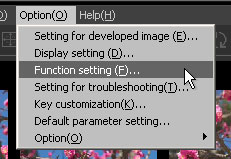 The menu command [Option(O)]-[Function setting(F)] displays the "Function setting" dialog in which you can set a method of saving the rotation for JPEG/TIFF/DNG, a brightness level of exposure bias tool and so forth.
The menu command [Option(O)]-[Function setting(F)] displays the "Function setting" dialog in which you can set a method of saving the rotation for JPEG/TIFF/DNG, a brightness level of exposure bias tool and so forth.9.3.1 Setting
9.3.1.1 Saving Rotation for JPEG/TIFF/DNG
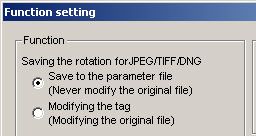 When rotating the image of JPEG/TIFF/DNG files, there are two ways to record the rotation information. You can specify whether or not to overwrite rotation information in the original file.
When rotating the image of JPEG/TIFF/DNG files, there are two ways to record the rotation information. You can specify whether or not to overwrite rotation information in the original file.
• Save to the parameter file (Never modify the original file)
9.3.1.2 Setting up Exposure Bias Tool
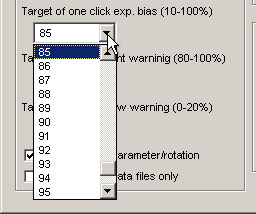 You can set a "brightness level" at the point where you click with the "Exposure bias tool". The exposure bias is adjusted to meet the brightness level as you set here.
You can set a "brightness level" at the point where you click with the "Exposure bias tool". The exposure bias is adjusted to meet the brightness level as you set here.
The "brightness level" means a value on a linear basis (photo energy) at the point you click. In other words, it is a value before adjusting contrast, gamma and tone curve.
Therefore, even if you set 50%, a pixel value at the point does not become 127. The pixel value becomes the brightness level that is displayed on a display. which is processed with contrast, gamma and tone curve.
Please consider that this value is treated as the image sensor level on the RAW data.
For example, when setting this value as 18% and using the exposure bias tool by clicking on the "18% gray card" portion, you can obtain the exposure bias value that the pixel value on the RAW data is treated as 18% gray level.
You can obtain almost the same result as a case of determining an exposure bias by using an exposure meter.
If setting this value 85% even when not using a gray card, you can adjust an exposure bias to a certain level easily by clicking the brightest portion such as a white paper with the \nohit"Exposure bias tool", because the reflectance of a white paper is approximately between 80 to 90%.}
You can reproduce the brightness which is the same as the other scene at the same point by applying this technique, when taking multiple photographs of the same scene.
9.3.1.3 Setting up Highlight Warning
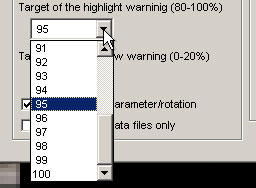 You can set a threshold value to execute the highlight warning. This value must be specified as a ratio to the maximum pixel value of the developed image.
You can set a threshold value to execute the highlight warning. This value must be specified as a ratio to the maximum pixel value of the developed image.
9.3.1.4 Setting up Shadow Warning
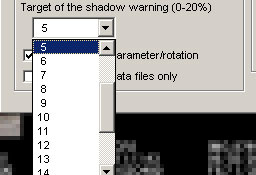 You can set a threshold value to execute the shadow warning. This value must be specified as a ratio to the maximum pixel value of the developed image.
You can set a threshold value to execute the shadow warning. This value must be specified as a ratio to the maximum pixel value of the developed image.
9.3.1.5 Enable Saving Parameter/Rotation
 You can specify whether or not to save their information automatically when changing a development parameter and rotation information.
You can specify whether or not to save their information automatically when changing a development parameter and rotation information.
If this setting is not checked, the modified development parameters and rotation information are lost when this software is finished or when a new file or folder is selected.
If this setting is checked, data files (spd, spi) for SILKYPIX® are created automatically into the "SILKYPIX_DS" sub folder on the folder in which a RAW data file exists.
When this setting is not checked or a storage media is write-protected, these folders and files are not created.
9.3.1.6 Operate RAW Data Files Only
 You can select this option to operate a RAW data file only.
You can select this option to operate a RAW data file only.
When this setting is not checked, RAW/JPEG/TIFF files are displayed together.
When this setting is checked, only a RAW data file is displayed.
* When this setting is checked, you cannot operate the RAW data file of EOS-1D or EOS-1Ds, because the extension of their RAW data file is "TIF" that is same as a TIFF image file.
9.3.2 Operation When rotating the image of JPEG/TIFF/DNG files, there are two ways to record the rotation information. You can specify whether or not to overwrite rotation information in the original file.
When rotating the image of JPEG/TIFF/DNG files, there are two ways to record the rotation information. You can specify whether or not to overwrite rotation information in the original file.• Save to the parameter file (Never modify the original file)
The rotation information will be recorded in a parameter file, and the original file is not modified.
• Modify the tag (Modify the original file)The rotation information will be recorded into the original file which will be modified.
Since the rotation information is overwritten in the original file, other software (*) besides SILKYPIX® can recognize rotation information.
However, if no rotation information is recorded in the original file, rotation information cannot be overwritten, and it is recorded in the parameter file (.spd).
* Software must be compatible with rotation information which is recorded in the orientation tag of EXIF.Since the rotation information is overwritten in the original file, other software (*) besides SILKYPIX® can recognize rotation information.
However, if no rotation information is recorded in the original file, rotation information cannot be overwritten, and it is recorded in the parameter file (.spd).
 You can set a "brightness level" at the point where you click with the "Exposure bias tool". The exposure bias is adjusted to meet the brightness level as you set here.
You can set a "brightness level" at the point where you click with the "Exposure bias tool". The exposure bias is adjusted to meet the brightness level as you set here.The "brightness level" means a value on a linear basis (photo energy) at the point you click. In other words, it is a value before adjusting contrast, gamma and tone curve.
Therefore, even if you set 50%, a pixel value at the point does not become 127. The pixel value becomes the brightness level that is displayed on a display. which is processed with contrast, gamma and tone curve.
Please consider that this value is treated as the image sensor level on the RAW data.
For example, when setting this value as 18% and using the exposure bias tool by clicking on the "18% gray card" portion, you can obtain the exposure bias value that the pixel value on the RAW data is treated as 18% gray level.
You can obtain almost the same result as a case of determining an exposure bias by using an exposure meter.
If setting this value 85% even when not using a gray card, you can adjust an exposure bias to a certain level easily by clicking the brightest portion such as a white paper with the \nohit"Exposure bias tool", because the reflectance of a white paper is approximately between 80 to 90%.}
You can reproduce the brightness which is the same as the other scene at the same point by applying this technique, when taking multiple photographs of the same scene.
 You can set a threshold value to execute the highlight warning. This value must be specified as a ratio to the maximum pixel value of the developed image.
You can set a threshold value to execute the highlight warning. This value must be specified as a ratio to the maximum pixel value of the developed image. You can set a threshold value to execute the shadow warning. This value must be specified as a ratio to the maximum pixel value of the developed image.
You can set a threshold value to execute the shadow warning. This value must be specified as a ratio to the maximum pixel value of the developed image. You can specify whether or not to save their information automatically when changing a development parameter and rotation information.
You can specify whether or not to save their information automatically when changing a development parameter and rotation information.If this setting is not checked, the modified development parameters and rotation information are lost when this software is finished or when a new file or folder is selected.
If this setting is checked, data files (spd, spi) for SILKYPIX® are created automatically into the "SILKYPIX_DS" sub folder on the folder in which a RAW data file exists.
When this setting is not checked or a storage media is write-protected, these folders and files are not created.
 You can select this option to operate a RAW data file only.
You can select this option to operate a RAW data file only.When this setting is not checked, RAW/JPEG/TIFF files are displayed together.
When this setting is checked, only a RAW data file is displayed.
* When this setting is checked, you cannot operate the RAW data file of EOS-1D or EOS-1Ds, because the extension of their RAW data file is "TIF" that is same as a TIFF image file.
9.3.2.1 Assign Double Click Operation as Selecting Folder
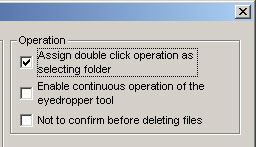 You can select the operation of double-clicking on a folder in the "Select folder" dialog.
You can select the operation of double-clicking on a folder in the "Select folder" dialog.
When this setting is checked, you can decide the folder to open by double-clicking.
When this setting is not checked, you can open or close the folder on the tree view by double-clicking. In another word, it is an operation for the tree view in this case.
9.3.2.2 Enable Continuous Operation of Eyedropper Tool
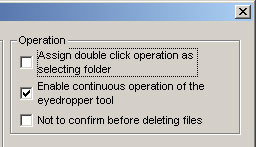 The eyedropper tool consists of "Exposure bias tool", "Gray balance tool", "Skin color tool", "Chromatic aberration tool" and "Add point tool for Tone curve".
The eyedropper tool consists of "Exposure bias tool", "Gray balance tool", "Skin color tool", "Chromatic aberration tool" and "Add point tool for Tone curve".
When this setting is checked, an operation mode does not change even if you specify a point or area with these tools once. And you can continue to operate with the same tool.
When this setting is not checked, these tools function as a one shot tool. And operation mode will be changed to the previous mode after using a tool.
In addition, when you use these tools with [SHIFT] key, the "one shot" and the "continuous operation" function oppositely to the setting.
9.3.2.3 Not to Confirm before Deleting Files
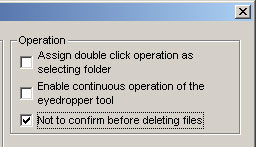 You can set whether to confirm or not when you delete a file.
You can set whether to confirm or not when you delete a file.
If this setting is not checked, you need to confirm when you delete a file.
If this setting is checked, you can delete a file without confirmation.
9.3.3 Performance You can select the operation of double-clicking on a folder in the "Select folder" dialog.
You can select the operation of double-clicking on a folder in the "Select folder" dialog.When this setting is checked, you can decide the folder to open by double-clicking.
When this setting is not checked, you can open or close the folder on the tree view by double-clicking. In another word, it is an operation for the tree view in this case.
 The eyedropper tool consists of "Exposure bias tool", "Gray balance tool", "Skin color tool", "Chromatic aberration tool" and "Add point tool for Tone curve".
The eyedropper tool consists of "Exposure bias tool", "Gray balance tool", "Skin color tool", "Chromatic aberration tool" and "Add point tool for Tone curve".When this setting is checked, an operation mode does not change even if you specify a point or area with these tools once. And you can continue to operate with the same tool.
When this setting is not checked, these tools function as a one shot tool. And operation mode will be changed to the previous mode after using a tool.
In addition, when you use these tools with [SHIFT] key, the "one shot" and the "continuous operation" function oppositely to the setting.
 You can set whether to confirm or not when you delete a file.
You can set whether to confirm or not when you delete a file.If this setting is not checked, you need to confirm when you delete a file.
If this setting is checked, you can delete a file without confirmation.
9.3.3.1 Enable Cache Preview
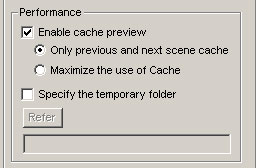 You can enable cache for preview and cache preview images of the previous and next scenes of the selected scene into cache memory.
You can enable cache for preview and cache preview images of the previous and next scenes of the selected scene into cache memory.
This is effective when you check details on a picture by switching two pictures on the preview screen.
When you check this setting, memory space for cache increases. When you use a PC with little memory, please uncheck this function.
• Only previous and next scene cache
9.3.3.2 Specify Temporary Folder
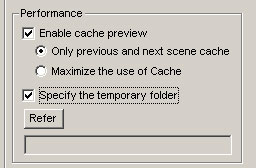 You can specify the folder in which this software creates a virtual storage file. Please check "Specify the temporary folder" checkbox, and specify a folder by clicking the [Refer] button.
You can specify the folder in which this software creates a virtual storage file. Please check "Specify the temporary folder" checkbox, and specify a folder by clicking the [Refer] button.
If you can specify a folder in a physically different drive from the drive which OS is installed, performance may improve.
When you specify a drive, you should specify the drive which has sufficient free storage space and also runs at as high speed as possible.
 You can enable cache for preview and cache preview images of the previous and next scenes of the selected scene into cache memory.
You can enable cache for preview and cache preview images of the previous and next scenes of the selected scene into cache memory.This is effective when you check details on a picture by switching two pictures on the preview screen.
When you check this setting, memory space for cache increases. When you use a PC with little memory, please uncheck this function.
• Only previous and next scene cache
When this setting is selected, SILKYPIX® caches only the previous and the next scenes and you can move to the previous scene or to the next scene quickly.
You can check details on a picture by switching two pictures on the preview screen comfortably.
• Maximize the use of CacheYou can check details on a picture by switching two pictures on the preview screen comfortably.
You can cache intermediate development result and developed result of the five scenes at a maximum and the four sets of cloakroom.
You can switch scenes quickly in the preview mode by the previous and next scene feed function.
If you compare scenes by feeding to the previous and next scene with multiple pixels, you can check focus on the scenes that were taken in the continuous shooting mode and camera shake easily.
Also, when executing putting development parameter on cloakroom, the development result is also cached simultaneously. When you compare scenes by switching the parameters on the cloakroom, you can switch to the preview quickly and run-in development parameters easily.
You can switch scenes quickly in the preview mode by the previous and next scene feed function.
If you compare scenes by feeding to the previous and next scene with multiple pixels, you can check focus on the scenes that were taken in the continuous shooting mode and camera shake easily.
Also, when executing putting development parameter on cloakroom, the development result is also cached simultaneously. When you compare scenes by switching the parameters on the cloakroom, you can switch to the preview quickly and run-in development parameters easily.
| If you enable the "Maximize the use of Cache" setting, please prepare enough memory space for caching. You need at least 1GByte memory in your PC and equal or more than 2GByte memory is recommended. |
 You can specify the folder in which this software creates a virtual storage file. Please check "Specify the temporary folder" checkbox, and specify a folder by clicking the [Refer] button.
You can specify the folder in which this software creates a virtual storage file. Please check "Specify the temporary folder" checkbox, and specify a folder by clicking the [Refer] button.If you can specify a folder in a physically different drive from the drive which OS is installed, performance may improve.
When you specify a drive, you should specify the drive which has sufficient free storage space and also runs at as high speed as possible.
 * You can display each setting dialog by the [Settings] button on the toolbar.
* You can display each setting dialog by the [Settings] button on the toolbar.9.4 Setting for Troubleshooting
You can set following settings according to the instruction from our support when troubles occur in your system environment.
Note that when you change settings by your own judgment, there is a possibility that a program does not run normally, or the performance drops significantly.
9.4.1 Troubleshooting for Windows
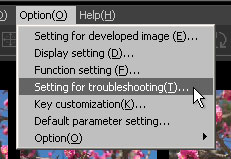
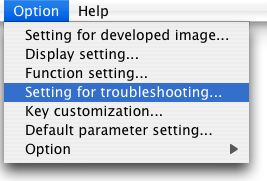
9.4.2.1 Disable Parallel Processing When Developing
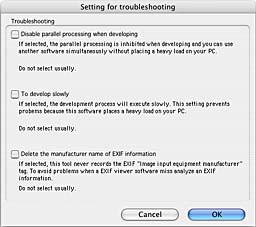 In order to achieve smooth operation even during complicated processing, SILKYPIX® has adopted multithread processing and multiprocessing in a positive way and achieved high performance by operating microprocessors with high efficiency.
In order to achieve smooth operation even during complicated processing, SILKYPIX® has adopted multithread processing and multiprocessing in a positive way and achieved high performance by operating microprocessors with high efficiency.
As the result, there is a possibility that SILKYPIX® decreases the other software's operations that are running simultaneously because the microprocessors are handling heavy loads during development processing.
This setting is used when you want to reduce slowdown of other software's processing speed during development processing, or to avoid any trouble causing errors during development processing.
9.4.2.2 To Develop Slowly
9.4.2.3 Delete Manufacturer Name of EXIF Information
Note that when you change settings by your own judgment, there is a possibility that a program does not run normally, or the performance drops significantly.
9.4.1 Troubleshooting for Windows

9.4.1.1 Disable to Access Files with Memory-mapped Method
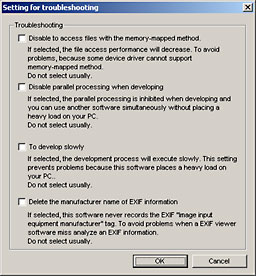 Avoids problems that some device drivers of a certain storage device cannot access files with the memory-mapped method.
Avoids problems that some device drivers of a certain storage device cannot access files with the memory-mapped method.
9.4.1.2 Disable Parallel Processing When Developing
9.4.2 Setting for Troubleshooting Macintosh Avoids problems that some device drivers of a certain storage device cannot access files with the memory-mapped method.
Avoids problems that some device drivers of a certain storage device cannot access files with the memory-mapped method. In order to achieve smooth operation even during complicated processing, SILKYPIX® has adopted multithread processing and multiprocessing in a positive way and achieved high performance by operating microprocessors with high efficiency.
As the result, there is a possibility that SILKYPIX® decreases performance of the other software which are running simultaneously because the microprocessors are handling heavy loads during development processing.
In addition, because the microprocessors are handling heavy loads, hardware operational failure has been reported. For example, a high temperature warning because of increased temperature of the processors, unstable operation, rebooting a PC and so forth.
In order to avoid these trouble, this setting controls microprocessor activity ratio and limits temperature rise.
Furthermore, if you want to specify more enhanced setting for limiting temperature rise, refer to '9.4.1.3 To Develop Slowly'.
Also, in order to run other software comfortably while executing batch development, refer to '5.2.5 Low Priority Development'.
9.4.1.3 To Develop SlowlyAs the result, there is a possibility that SILKYPIX® decreases performance of the other software which are running simultaneously because the microprocessors are handling heavy loads during development processing.
In addition, because the microprocessors are handling heavy loads, hardware operational failure has been reported. For example, a high temperature warning because of increased temperature of the processors, unstable operation, rebooting a PC and so forth.
In order to avoid these trouble, this setting controls microprocessor activity ratio and limits temperature rise.
Furthermore, if you want to specify more enhanced setting for limiting temperature rise, refer to '9.4.1.3 To Develop Slowly'.
Also, in order to run other software comfortably while executing batch development, refer to '5.2.5 Low Priority Development'.
This setting aims for verifying trouble of CPU thermal runaway caused by temperature rise.
When this setting is checked, all development processes such as creating preview and thumbnail, 1-scene development, batch development and so forth are executed slowly.
By executing development process slowly and reducing the amount of load placed on CPU, heat generation of CPU can be controlled.
If the thermal runaway occurs while executing development process and changing development parameters, you should check this setting.
If the thermal runaway does not occur when you check this setting, there may be a problem about the countermeasure of heating in your PC environment.
If you continue to use a PC in this condition, the thermal runaway may give some damage to your PC, for example, break the data recorded in a hard disk.
[Thermal Runaway]
9.4.1.4 Delete Manufacturer Name of EXIF InformationWhen this setting is checked, all development processes such as creating preview and thumbnail, 1-scene development, batch development and so forth are executed slowly.
By executing development process slowly and reducing the amount of load placed on CPU, heat generation of CPU can be controlled.
If the thermal runaway occurs while executing development process and changing development parameters, you should check this setting.
If the thermal runaway does not occur when you check this setting, there may be a problem about the countermeasure of heating in your PC environment.
If you continue to use a PC in this condition, the thermal runaway may give some damage to your PC, for example, break the data recorded in a hard disk.
[Thermal Runaway]
When this damage occurs, you need to stop using this software and execute the following measures.
This "To develop slowly" aims for only discovering trouble. Even though a PC runs with stability in this mode, it is dangerous to use it continuously in this condition.
In the case of thermal runaway, there is a high possibility that breakage of data recorded in a hard disk will occur. This is quite different from a case that program runs abnormally and completes.
At the worst, the OS itself will not start up, and all data will be lost. We strongly recommend you not to use your PC continuously in this "To develop slowly" enabled.
1. Is there any obstacle around a cooling fan in a PC?
This "To develop slowly" aims for only discovering trouble. Even though a PC runs with stability in this mode, it is dangerous to use it continuously in this condition.
In the case of thermal runaway, there is a high possibility that breakage of data recorded in a hard disk will occur. This is quite different from a case that program runs abnormally and completes.
At the worst, the OS itself will not start up, and all data will be lost. We strongly recommend you not to use your PC continuously in this "To develop slowly" enabled.
1. Is there any obstacle around a cooling fan in a PC?
You need to check whether dust clogs a fan or a fan is covered with dust. If it is too dirty, you should clean it according to a manual of your PC.
2. Is PC installed at an appropriate place?You need to check whether a wall blocks ventilation of fan or thermal radiation because a wall is too close to a PC. You should avoid locating a PC where heat stays. Rather you should install it where ventilation is good.
If a room temperature is high, you should be careful for heat radiation from a PC. You may install it near to an air conditioner.
3. Please consult a manufacturer.If a room temperature is high, you should be careful for heat radiation from a PC. You may install it near to an air conditioner.
SILKYPIX® Developer Studio runs a CPU with high efficiency. Because of this, we say that a temperature of CPU gets higher than a case of running other software.
However, if a PC does not stand the heat, a problem does exist in a PC.
If thermal runaway occurs even in an appropriate locating condition, there is a possibility that PC's countermeasure to heat is not perfect.
You should consult a manufacturer about this thermal runaway.
You may be suggested to initialize BIOS or update it. You need to follow directions given from a manufacturer to take measures.
4. In the case of a self-made PC, please enhance countermeasure for cooling.However, if a PC does not stand the heat, a problem does exist in a PC.
If thermal runaway occurs even in an appropriate locating condition, there is a possibility that PC's countermeasure to heat is not perfect.
You should consult a manufacturer about this thermal runaway.
You may be suggested to initialize BIOS or update it. You need to follow directions given from a manufacturer to take measures.
Is grease between CPU and heat sink sufficient? Is capacity of fan enough? Is ventilation in a PC ensured? Please enhance a heat radiation capacity.
It is quite effective to open a PC and to blow air directly from a fan into it.
It is quite effective to open a PC and to blow air directly from a fan into it.
This setting aims for avoiding the trouble which the EXIF information is displayed incorrectly by some other software like an EXIF viewer tool.

9.4.2.1 Disable Parallel Processing When Developing
 In order to achieve smooth operation even during complicated processing, SILKYPIX® has adopted multithread processing and multiprocessing in a positive way and achieved high performance by operating microprocessors with high efficiency.
In order to achieve smooth operation even during complicated processing, SILKYPIX® has adopted multithread processing and multiprocessing in a positive way and achieved high performance by operating microprocessors with high efficiency.As the result, there is a possibility that SILKYPIX® decreases the other software's operations that are running simultaneously because the microprocessors are handling heavy loads during development processing.
This setting is used when you want to reduce slowdown of other software's processing speed during development processing, or to avoid any trouble causing errors during development processing.
9.4.2.3 Delete Manufacturer Name of EXIF Information
This setting aims for avoiding the trouble which the EXIF information is displayed incorrectly by some other software like an EXIF viewer tool.
9.5 Key Customization
The menu command [Option(O)]-[Key customization(K)] displays the "Key customization" dialog in which you can customize shortcut keys.
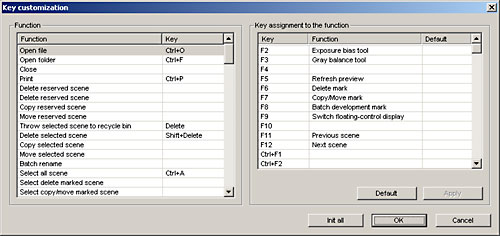 |
• Assign key to the Function
Select a function from the [Function] list at the left side of the dialog at first.
Next, select a key to assign to the selected function from the [Key assignment to the function] list at the right side of the dialog.
Click the [Apply] button to assign the key to the selected function.
• Initialize the assigned key to the defaultNext, select a key to assign to the selected function from the [Key assignment to the function] list at the right side of the dialog.
Click the [Apply] button to assign the key to the selected function.
Select a function from the [Function] list at the left side of the dialog at first.
Click the [Default] button and then click the [Apply] button, to initialize the key setting of the selected function.
• Initialize all keys to the defaultClick the [Default] button and then click the [Apply] button, to initialize the key setting of the selected function.
Click the [Init all] button to initialize all key's settings to the default.
9.6 Default Parameter Setting
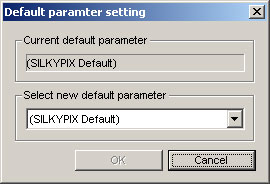 The menu command [Option(O)]-[Default Parameter Setting...] displays the "Default Parameter Setting" dialog.
The menu command [Option(O)]-[Default Parameter Setting...] displays the "Default Parameter Setting" dialog.You can register the taste as the default parameter, which was registered to "All parameters" of "Taste category".
"(SILKYPIX® Default)" is the default setting prepared by SILKYPIX®.
If you select a "partial taste" for the default parameter, it is mixed for "(SILKYPIX® Default)" and the composite development parameter is assigned as the default parameter.
[Attention]
The default parameter must be modified carefully. When you modify the default parameter, the developed result of all scenes which a development parameter isn't set to is changed all together.
Even if it is the scene which was browsed or developed in the past by SILKYPIX, the developed image is not compatible with the past in case of the scene which was not set a development parameter.
As for the scene which a development parameter was once set to, it doesn't have an influence therefore.
* You can check whether a development parameter was set or not by "Dropdown list for Taste". If the development parameter was not set and it is same as the default, it's taste is displayed with green color.
* This function is valid only for RAW. You cannot specify the default parameter for JPEG/TIFF because it is fixed.
Even if it is the scene which was browsed or developed in the past by SILKYPIX, the developed image is not compatible with the past in case of the scene which was not set a development parameter.
As for the scene which a development parameter was once set to, it doesn't have an influence therefore.
* You can check whether a development parameter was set or not by "Dropdown list for Taste". If the development parameter was not set and it is same as the default, it's taste is displayed with green color.
* This function is valid only for RAW. You cannot specify the default parameter for JPEG/TIFF because it is fixed.
9.7 Option Feature
9.7.1 Make Thumbnail Files of All Scene
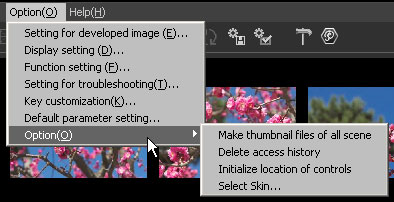 This function makes a thumbnail file of all scenes.
This function makes a thumbnail file of all scenes.
9.7.2 Delete Access History
 This function makes a thumbnail file of all scenes.
This function makes a thumbnail file of all scenes.This function deletes an access history to files/folders.
9.7.3 Initializing Location of ControlThis function initializes the location of all controls to the default.
9.7.4 Select SkinThis function allows you to change the background skin of this software. It displays the "Select skin" dialog, and you can select a skin on the dialog.
This setting will be applied after re-execution of this software. To display with the new skin, please close this software once and re-execute it.
This setting will be applied after re-execution of this software. To display with the new skin, please close this software once and re-execute it.
9.8 Customize Control Location
This is a feature that allows you to change each control location. You can put sub-controls to the "tab page" or the "control box", or change to a floating window.
And also you can change entire "parameter control" location.
This is a very convenient function that allows you to compare two or more parameters and allows you to see and verify all of the pictures on the screen.
[How to use]
And also you can change entire "parameter control" location.
This is a very convenient function that allows you to compare two or more parameters and allows you to see and verify all of the pictures on the screen.
[How to use]
1. About the sub-controls located on the "tab page" or the "control box" within the "parameter control" (for example "Exposure bias" or "White balance" as default) , you can change these sub-controls to a floating window by system menu command that is appeared by right-clicking on the title bar area of each sub-control.
2. You can change the entire "parameter control" to a floating window. The menu command [Option(O)]-[Display setting(D)] displays the "Display setting" dialog, and you can change setting of "Control location".
3. About the sub-controls displayed as a floating window (for example "Tone curve" or "Histogram" as default) , you can change these sub-controls to locate in the "control box" within the "parameter control" by system menu command that is appeared by right-clicking on the title bar area of each sub-control.
You need enough display space for the "control box" area to locate any sub-controls.
 Setting the Floating window |
2. You can change the entire "parameter control" to a floating window. The menu command [Option(O)]-[Display setting(D)] displays the "Display setting" dialog, and you can change setting of "Control location".
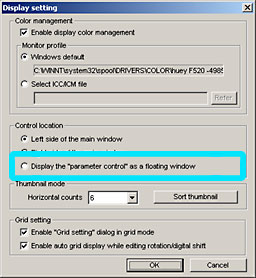 |
3. About the sub-controls displayed as a floating window (for example "Tone curve" or "Histogram" as default) , you can change these sub-controls to locate in the "control box" within the "parameter control" by system menu command that is appeared by right-clicking on the title bar area of each sub-control.
You need enough display space for the "control box" area to locate any sub-controls.
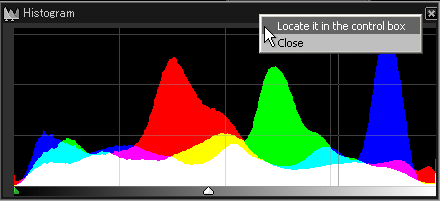 Housing a Parameter Window |